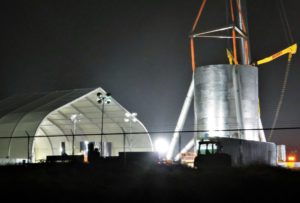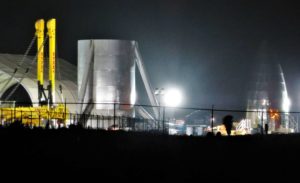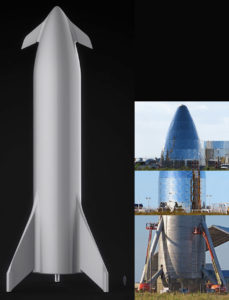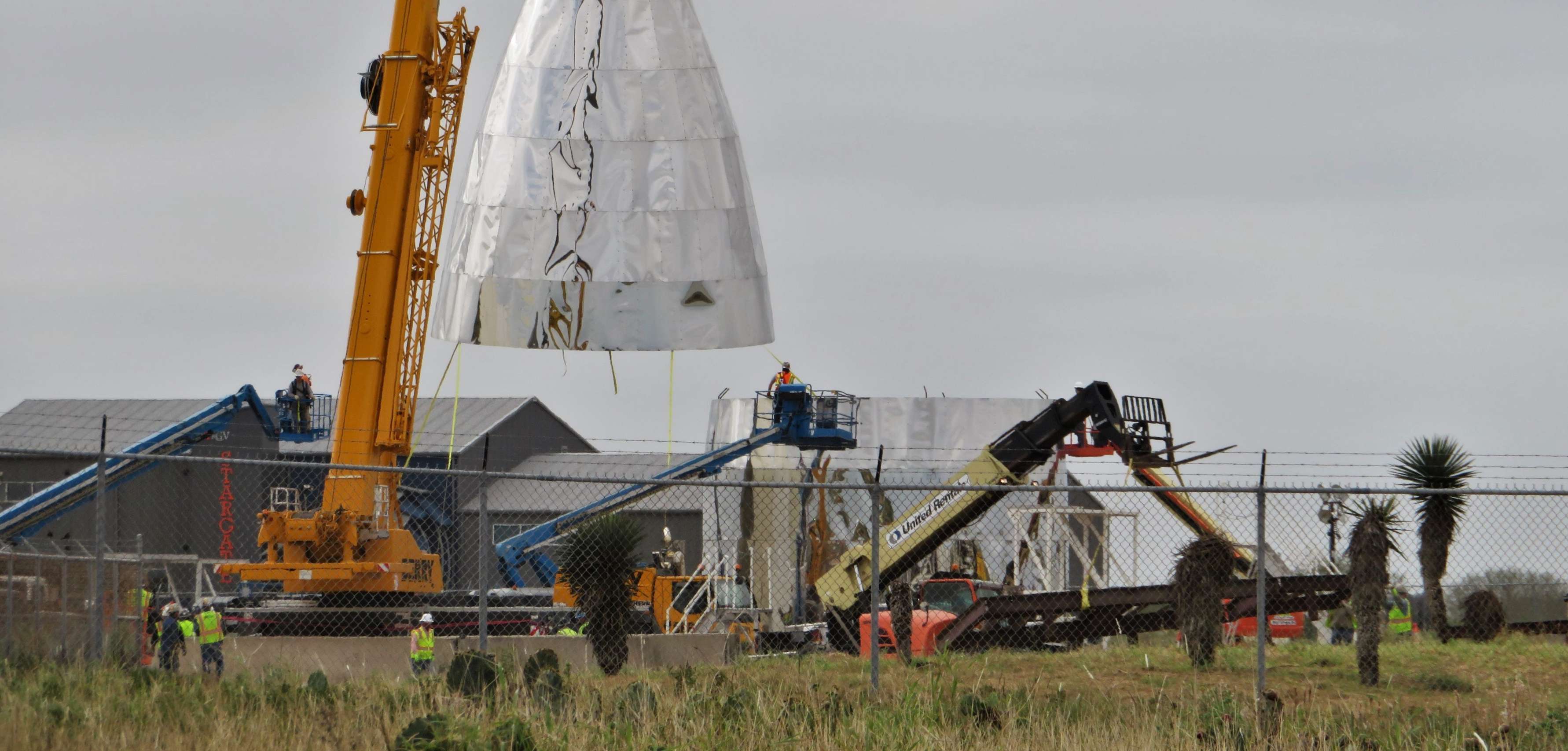

News
SpaceX’s Starship prototype proceeds at breakneck pace towards hop tests
Well illustrated by recent drone photos of SpaceX’s up-and-coming Boca Chica, Texas facilities, dozens of SpaceXers and local contractors have congregated at the company’s Starship prototype work site over the last few weeks, progressing it from an empty tent and a collection of parts to a handful of large assemblies for what appears to be the first full-scale Starship hopper.
Much like Falcon 9’s Grasshopper and F9R (Reusable) hop test articles, this ungainly Starship hopper – standing an impressive 9m (29.5 ft) wide and ~40m (131 ft) tall – appears all but guaranteed to become the first integrated BFR hardware to take flight, hopefully supporting a productive series of low-altitude hop tests from a roughly-prepared South Texas pad.
https://twitter.com/austinbarnard45/status/1079402956603248641
Since SpaceX CEO Elon Musk took to Twitter to provide a number of updates on and photos of the company’s dramatically refigured approach to BFR (now Starship and Super Heavy), employees and local contractors have been working almost around the clock to keep building the first full-scale, integrated Starship test article. To be dedicated to low-speed, low-altitude hop tests, Starhopper has been a spectacle and scandal from the start thanks to an unshakable visual aesthetic reminiscent of 1950s science fiction or an elaborate and slow-burning April Fool’s prank.
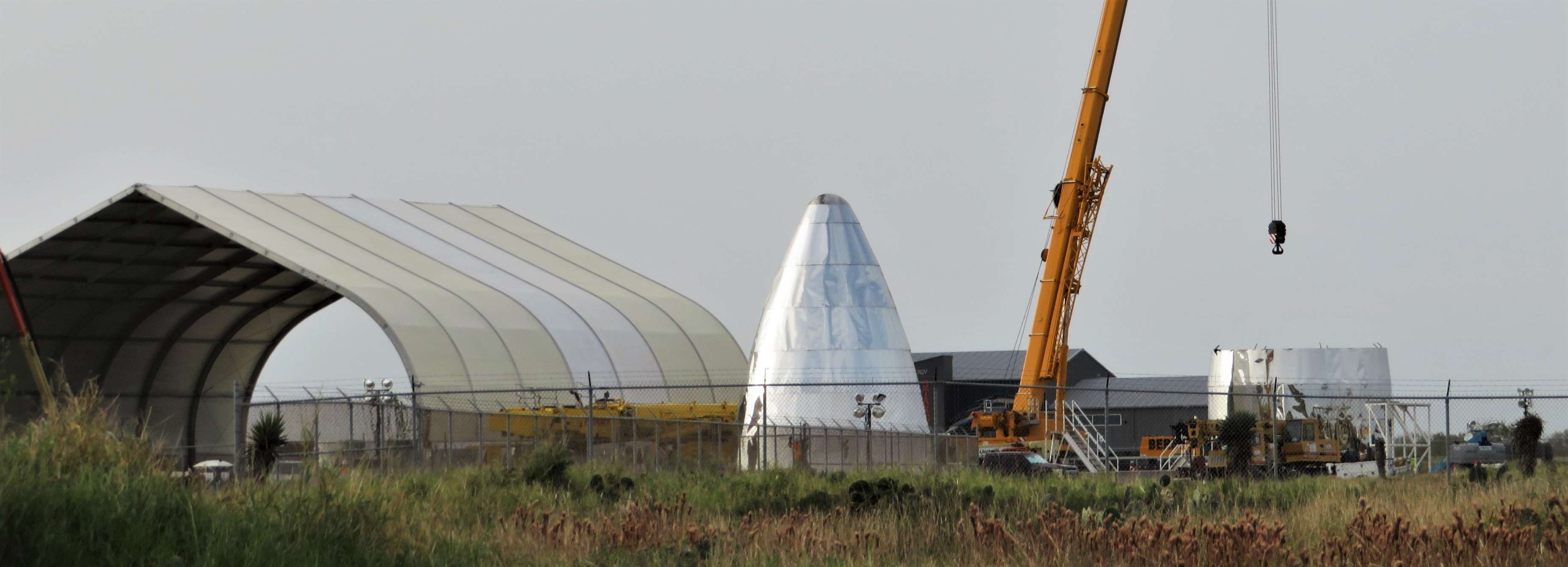
As of now, several dozen tweets and tweet replies from Musk in just the last week offer extensive support for the unorthodox new design – replacing carbon composites and an ablative heat shield for a new stainless steel alloy and liquid cooling – while also firmly indicating that the object taking shape in South Texas really is a Starship hopper that will eventually take to the skies on a pillar of Raptor engine exhaust. Those inaugural hop tests could apparently begin as early as March or April 2019. Given Musk’s statements, it seems that this highly unusual Starship hop test program simply cannot be judged accurately by its cover, at least not easily.
Even for SpaceX, building an aerospace-grade prototype of a massive orbital spaceship outdoors – adjacent to soggy Texan marshland and Gulf of Mexico sea spray, no less – is utterly and completely unexpected, especially in an industry where rocket hardware is routinely fabricated indoors, if not in medical-grade clean rooms. The most likely explanation here is that we are seeing something more akin to the aeroshell or cocoon of a Starship hopper, with a huge amount of thought and debate ultimately landing on this oddity as the fastest, most affordable, and most data-rich path forward for full-scale BFR testing.
- A welder can be seen attaching a patch layer over each panel layer gap on Dec. 30. (NASASpaceflight /u/bocachicagal)
- A lifting sling is seen here attached to Starhopper’s bottom half prior to its first lift and move. (NASASpaceflight /u/bocachicagal)
- Before the move… (NASASpaceflight /u/bocachicagal)
- And after the move. (NASASpaceflight /u/bocachicagal)
- The leftmost mockup was stitched together from NASASpaceflight user bocachicagal’s on-site photos by Thomas Lacroix. The TL;DR of this is that Starhopper appears to be a solid three-quarters the height of a full 2018 BFS. (SpaceX, NASASpaceflight, Thomas Lacroix)
In this speculative instance, the sensitive liquid methane and liquid oxygen propellant tanks – as well as Starhopper’s triple-Raptor thrust structure and spaghetti plumbing – would be fabricated in SpaceX’s Hawthorne, CA factory or McGregor, TX test facilities before being shipped to Boca Chica for integration with the large structures already in work there. Those Raptors, propellant tanks, and a general program of fit-and-finish optimizations are next on the list of significant Starhopper-related events expected to occur within the next several months.
The latter task has already begun, showing up in the form of sheet metal refinement by way of essentially stitching together loose panel gaps between and within sheet-covered sections of Starhopper’s shiny silver nose. SpaceX workers also conducted the first move of the fully-integrated hopper’s base section, previously built and then sat atop a ready-made concrete stand that may or may not have come from a water tank design. While the move was slight, the base and nose sections are now roughly side-by-side along the apron of SpaceX’s temporary tent, where a third Starhopper hull segment is being built up.
2019 is going to be wild and March/April simply cannot come soon enough.
For prompt updates, on-the-ground perspectives, and unique glimpses of SpaceX’s rocket recovery fleet check out our brand new LaunchPad and LandingZone newsletters!
News
These Tesla, X, and xAI engineers were just poached by OpenAI
The news is the latest in an ongoing feud between Elon Musk and the Sam Altman-run firm OpenAI.

OpenAI, the xAI competitor for which Elon Musk previously served as a boardmember and helped to co-found, has reportedly poached high-level engineers from Tesla, along with others from xAI, X, and still others.
On Tuesday, Wired reported that OpenAI hired four high-level engineers from Tesla, xAI, and X, as seen in an internal Slack message sent by co-founder Greg Brockman. The engineers include Tesla Vice President of Software Engineering David Lau, X and xAI’s head of infrastructure engineering Uday Ruddarraju, and fellow xAI infrastructure engineer Mike Dalton. The hiring spree also included Angela Fan, an AI researcher from Meta.
“We’re excited to welcome these new members to our scaling team,” said Hannah Wong, an OpenAI spokesperson. “Our approach is to continue building and bringing together world-class infrastructure, research, and product teams to accelerate our mission and deliver the benefits of AI to hundreds of millions of people.”
Lau has been in his position as Tesla’s VP of Software Engineering since 2017, after previously working for the company’s firmware, platforms, and system integration divisions.
“It has become incredibly clear to me that accelerating progress towards safe, well-aligned artificial general intelligence is the most rewarding mission I could imagine for the next chapter of my career,” Lau said in a statement to Wired.
🚨Optimistic projections point to xAI possibly attaining profitability by 2027, according to Bloomberg's sources.
If accurate, this would be quite a feat for xAI. OpenAI, its biggest rival, is still looking at 2029 as the year it could become cash flow positive.💰 https://t.co/pE5Z9daez8
— TESLARATI (@Teslarati) June 18, 2025
READ MORE ON OPENAI: Elon Musk’s OpenAI lawsuit clears hurdle as trial looms
At xAI, Ruddarraju and Dalton both played a large role in developing the Colossus supercomputer, which is comprised of over 200,000 GPUs. One of the major ongoing projects at OpenAI is the company’s Stargate program,
“Infrastructure is where research meets reality, and OpenAI has already demonstrated this successfully,” Ruddarraju told Wired in another statement. “Stargate, in particular, is an infrastructure moonshot that perfectly matches the ambitious, systems-level challenges I love taking on.”
Elon Musk is currently in the process of suing OpenAI for shifting toward a for-profit model, as well as for accepting an investment of billions of dollars from Microsoft. OpenAI retaliated with a counterlawsuit, in which it alleges that Musk is interfering with the company’s business and engaging in unfair competition practices.
Elon Musk confirms Grok 4 launch on July 9 with livestream event
News
SpaceX share sale expected to back $400 billion valuation
The new SpaceX valuation would represent yet another record-high as far as privately-held companies in the U.S. go.

A new report this week suggests that Elon Musk-led rocket company SpaceX is considering an insider share sale that would value the company at $400 billion.
SpaceX is set to launch a primary fundraising round and sell a small number of new shares to investors, according to the report from Bloomberg, which cited people familiar with the matter who asked to remain anonymous due to the information not yet being public. Additionally, the company would sell shares from employees and early investors in a follow-up round, while the primary round would determine the price for the secondary round.
The valuation would represent the largest in history from a privately-owned company in the U.S., surpassing SpaceX’s previous record of $350 billion after a share buyback in December. Rivaling company valuations include ByteDance, the parent company of TikTok, as well as OpenAI.
Bloomberg went on to say that a SpaceX representative didn’t respond to a request for comment at the time of publishing. The publication also notes that the details of such a deal could still change, especially depending on interest from the insider sellers and share buyers.
Axiom’s Ax-4 astronauts arriving to the ISS! https://t.co/WQtTODaYfj
— TESLARATI (@Teslarati) June 26, 2025
READ MORE ON SPACEX: SpaceX to decommission Dragon spacecraft in response to Pres. Trump war of words with Elon Musk
SpaceX’s valuation comes from a few different key factors, especially including the continued expansion of the company’s Starlink satellite internet company. According to the report, Starlink accounts for over half of the company’s yearly revenue. Meanwhile, the company produced its 10 millionth Starlink kit last month.
The company also continues to develop its Starship reusable rocket program, despite the company experiencing an explosion of the rocket on the test stand in Texas last month.
The company has also launched payloads for a number of companies and government contracts. In recent weeks, SpaceX launched Axiom’s Ax-4 mission, sending four astronauts to the International Space Station (ISS) for a 14-day stay to work on around 60 scientific experiments. The mission was launched using the SpaceX Falcon 9 rocket and a new Crew Dragon capsule, while the research is expected to span a range of fields including biology, material and physical sciences, and demonstrations of specialized technology.
News
Tesla Giga Texas continues to pile up with Cybercab castings
Tesla sure is gathering a lot of Cybercab components around the Giga Texas complex.

Tesla may be extremely tight-lipped about the new affordable models that it was expected to start producing in the first half of the year, but the company sure is gathering a lot of Cybercab castings around the Giga Texas complex. This is, at least, as per recent images taken of the facility.
Cybercab castings galore
As per longtime drone operator Joe Tegtmeyer, who has been chronicling the developments around the Giga Texas complex for several years now, the electric vehicle maker seems to be gathering hundreds of Cybercab castings around the factory.
Based on observations from industry watchers, the drone operator appears to have captured images of about 180 front and 180 rear Cybercab castings in his recent photos.
Considering the number of castings that were spotted around Giga Texas, it would appear that Tesla may indeed be preparing for the vehicle’s start of trial production sometime later this year. Interestingly enough, large numbers of Cybercab castings have been spotted around the Giga Texas complex in the past few months.
Cybercab production
The Cybercab is expected to be Tesla’s first vehicle that will adopt the company’s “unboxed” process. As per Tesla’s previous update letters, volume production of the Cybercab should start in 2026. So far, prototypes of the Cybercab have been spotted testing around Giga Texas, and expectations are high that the vehicle’s initial trial production should start this year.
With the start of Tesla’s dedicated Robotaxi service around Austin, it might only be a matter of time before the Cybercab starts being tested on public roads as well. When this happens, it would be very difficult to deny the fact that Tesla really does have a safe, working autonomous driving system, and it has the perfect vehicle for it, too.
-

 Elon Musk1 week ago
Elon Musk1 week agoTesla investors will be shocked by Jim Cramer’s latest assessment
-

 News2 weeks ago
News2 weeks agoTesla Robotaxi’s biggest challenge seems to be this one thing
-

 Elon Musk1 day ago
Elon Musk1 day agoElon Musk confirms Grok 4 launch on July 9 with livestream event
-

 News2 weeks ago
News2 weeks agoWatch the first true Tesla Robotaxi intervention by safety monitor
-

 News5 days ago
News5 days agoTesla Model 3 ranks as the safest new car in Europe for 2025, per Euro NCAP tests
-

 Elon Musk2 weeks ago
Elon Musk2 weeks agoA Tesla just delivered itself to a customer autonomously, Elon Musk confirms
-

 Elon Musk2 weeks ago
Elon Musk2 weeks agoElon Musk confirms Tesla Optimus V3 already uses Grok voice AI
-

 Elon Musk2 weeks ago
Elon Musk2 weeks agoxAI welcomes Memphis pollution results, environmental groups push back



